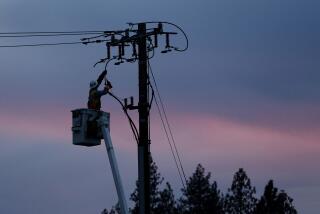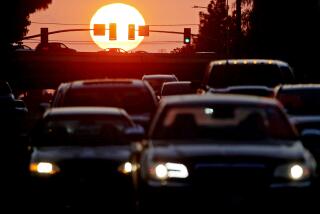Cars Sprout Antennas as Cellular Phones Ring Out Through the Southland
- Share via
Well, Kimberly Hubbard of Newport Beach did ask her husband to give her a ring for her birthday.
But a car phone?
Somehow that wasn’t quite what she had in mind.
“I could never reach her at home,” says Kimberly’s husband, Scott. Between shuttling their four children to and from school and running household errands, she spends a good part of her day behind the wheel of her Mercedes-Benz station wagon.
“Now my big problem is keeping her off the phone with her girlfriends,” he says.
But Kimberly didn’t hide her disappointment when she saw her gift. “I said, ‘No, no, no, this is not my birthday present.’ So he took me to get the ring too.”
“It’s really worked out great,” Kimberly says. “We bought a house and (the car phone) made going through escrow so much easier, because I had to take papers here and there. We went on vacation to San Francisco and called our friends (from the car) to get directions to their house.”
Forget the stereotype: The guy in the business suit in the BMW isn’t the only driver who’s gone cellular these days. Now that car phones are available for as little as $500 and cellular dealers are becoming as common as yogurt shops and nail parlors, more and more cars are sprouting those squiggly little antennas.
(Drivers who want the status but don’t need--or can’t afford--the service can get a phony phone. Last year a company called Faux Systems in San Francisco started selling fake cellular sets, with inoperative antennas and plastic phone shells, for $9.95.)
“At first, cellular was so new that a lot of people were intimidated by it,” says Angie Wolfer, sales manager for Cellular USA in Santa Ana. “But now that people are getting used to it, it’s not so much a luxury item anymore.”
Way back in the dawn of cellular (the technology was introduced in 1981 and became widely available here beginning in 1983), most customers were male business professionals, Wolfer says. “More women are buying phones now. And people who aren’t white-collar; construction guys are putting them in their trucks.”
Wolfer estimates that about a fourth of the car phones she now sells are being purchased primarily for personal, not business, purposes.
Although statistical breakdowns are not available specifically for Orange County, the greater Los Angeles area has the highest number of car phones in the nation, according to Linda Leavitt, a spokeswoman for LA Cellular, one of two companies that provide cellular service here. The other is Irvine-based PacTel Cellular.
California has 225,000 cellular subscribers, which account for a fifth of the national total. Leavitt says neither company will release exact figures on the number of subscribers in the Los Angeles area. “It has to be proprietary, because the competition is so hot.”
But Mark Gallardo, owner of Communications ‘r’ Us, which does business in both Orange and Los Angeles counties, says about 7,000 new lines are being added every month in the Los Angeles area.
In 1981, Leavitt says, car phones cost about $3,000 and there were only 125,000 cellular subscribers in the United States. Last year that number rose to 2.1 million, according to the Cellular Telecommunications Industry Assn. And those customers spent nearly $3.2 billion to make calls.
Car phones are nothing new, of course. But with the pre-cellular mobile telephone system, every car call had to go through an operator, and the connections were often less than ideal.
Like the old system, cellular uses radio waves, which are relayed by a grid of antennas, each covering a small geographic area called a cell. The cell antennas relay a call from a car unit to a mobile telephone switching office, which automatically routes the call. As you travel from one cell to another, your call is automatically switched to the next antenna.
Some dealers are affiliated with both PacTel Cellular and LA Cellular; others represent only one. Rates for both companies are identical, being regulated by the Public Utilities Commission, according to Wolfer.
Because charges are based on air time, cellular phone users are billed for both incoming and outgoing calls. “There are three plans,” Wolfer says. “The one that’s mostly for business users is $45 a month for the basic service, then 45 cents a minute during peak hours, 7 a.m. to 7 p.m. Monday through Friday, and 27 cents a minute evenings and weekends.
“For people who don’t need to make many calls during business hours, there’s a plan that costs $25 a month, plus 90 cents a minute during peak hours and 20 cents the rest of the time. Or for callers who use the phone more than 15 minutes a day, there’s the premium plan that costs $239 a month for 550 minutes of air time. The premium plan also includes call forwarding, call waiting and conference calling.”
Calls to anywhere in the 714, 213 and 818 area codes are considered local for cellular purposes. Long distance is measured by your area code, not where your car happens to be when you make a call. So when the Hubbards were in San Francisco and called their friends there, the call was long distance.
Some people have answering machines on their car phones and others have the phone’s ringer tied in to the horn, Wolfer says. Otherwise, “when you’re out of the car, the phone’s off. Or you can turn it off any time when you’re driving.”
There are three types of cellular phones, Wolfer says. The least expensive is called a fixed mobile, which means it is permanently installed in a car. Fixed mobile phones cost between $500 and $1,200, she says. The next level is transportables, which can be moved from car to car. Those cost $1,000 to $1,500, she says. The most expensive are hand-held cellular phones, which can be carried in a pocket. They cost between $1,300 and $1,700.
Installation (about $150 for all types) is extra.
Dealers make most of their money not on the phones themselves but on the monthly phone bills. Gallardo says he gets $200 to $250 from LA Cellular every time he signs up a new customer, plus 5% of the monthly bill for as long as that customer subscribes.
“People are getting rich in this business,” he says.
But what about safety? Isn’t it distracting, trying to drive and talk on the phone at the same time?
Although not many studies have been done on car phone safety so far, the early reports have found no problems. The Automobile Assn. of America and the California Highway Patrol both concluded that car phones pose no direct traffic hazards.
They may even help make highways safer. Drivers often use their car phones to report emergencies and road hazards, according to the CHP, which found that 98% of the calls to 911 from car phones were valid emergencies, compared to only 39% of the 911 calls from land lines.
Safety was a big reason Rhonda DeTorres Nobles of Fountain Valley got her car phone. Her husband, Anthony, already had a phone in his car for business purposes. But 2 years ago when she was pregnant with their first child, they had a phone installed in her car. Now she is expecting a second child; Rhonda said, “Next week we’re getting a mini-van and we’ll have a phone installed in it as well.
“We never use the phones for social calls and we don’t give out the numbers,” she says. Still, her monthly bill is about $150 and her husband’s usually is more than $200.
“I’ve wondered if it’s worth it, but we just feel more secure this way. If I’m out in the middle of the freeway with the baby in the car and I’m late, he worries. This way there’s almost no time when we’re out of touch.
“I feel much safer with a car phone, night or day,” she says.
Judith Meyer, also of Fountain Valley, says her car phone was a gift from her husband. A Realtor, Meyer says the phone has increased her business by about 20%. But she says it also makes her feel more secure. “Many times it is necessary for me to have late night appointments,” she says.
“As soon as I leave the appointment I can call home and assure my husband that I am on my way home. I would not stop at a pay phone late at night to call him.”
Frank Anderson of Irvine thinks most drivers who have car phones don’t really need them. “I do not have one, will not have one and feel perhaps one in 1,000 and less are, probably, in truth, justified. . . .
“In my opinion, the President of the United States has a constitutional requirement to be in touch and available (and hopefully rational) 100% of the time. From there I think the need goes down exponentially.”
Watch Out! Slow Down! Turn Left!
So many of us drive solo in Orange County that back-seat driving is becoming a lost art. But we’d like to preserve it by searching for the county’s best--and worst--back-seat drivers. Tell us about your favorite candidate for either category.
Trucks Vs. Cars
Can cars and trucks peacefully coexist on the same roads? Whether you drive a compact car or a tractor-trailer rig, tell us how you feel about those other vehicles who share the freeways with you.
Send your comments to Life on Wheels, Orange County Life, The Times, 1375 Sunflower Ave., Costa Mesa, Calif. 92626. Please include your phone number so that we can contact you. To protect your privacy, Life on Wheels does not publish correspondents’ last names when the subject is sensitive.
More to Read
Inside the business of entertainment
The Wide Shot brings you news, analysis and insights on everything from streaming wars to production — and what it all means for the future.
You may occasionally receive promotional content from the Los Angeles Times.









